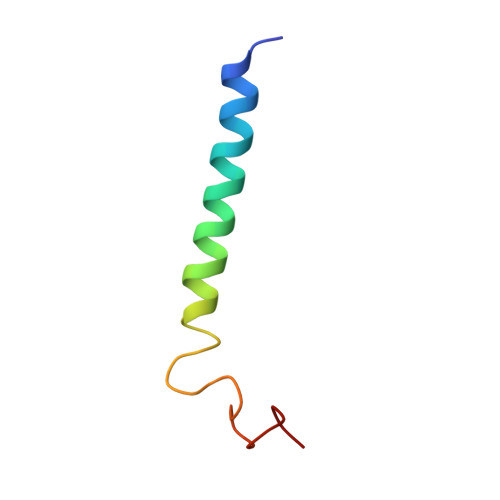NMR structure of the (52-96) C-terminal domain of the HIV-1 regulatory protein Vpr: molecular insights into its biological functions.
Schuler, W., Wecker, K., de Rocquigny, H., Baudat, Y., Sire, J., Roques, B.P.(1999) J Mol Biol 285: 2105-2117
- PubMed: 9925788
- DOI: https://doi.org/10.1006/jmbi.1998.2381
- Primary Citation of Related Structures:
1VPC - PubMed Abstract:
The HIV-1 regulatory protein Vpr (96 amino acid residues) is incorporated into the virus particle through a mechanism involving its interaction with the C-terminal portion of Gag. Vpr potentiates virus replication by interrupting cell division in the G2 phase and participates in the nuclear transport of proviral DNA. The domain encompassing the 40 C-terminal residues of Vpr was shown to be involved in cell cycle arrest and binding of nucleocapsid protein NCp7, and suggested to promote nuclear provirus transfer. Accordingly, we show here that the synthetic 52-96 but not 1-51 sequences of Vpr interact with HIV-1 RNA. Based on these results, the structure of (52-96)Vpr was analysed by two-dimensional 1H-NMR in aqueous TFE (30%) solution and refined by restrained molecular dynamics. The structure is characterized by a long (53-78) amphipathic alpha-helix, followed by a less defined (79-96) C-terminal domain. The Leu60 and Leu67 side-chains are located on the hydrophobic side of the helix, suggesting their involvement in Vpr dimerization through a leucine zipper-type mechanism. Accordingly, their replacement by Ala eliminates Vpr dimerization in the two hybrid systems, while mutations of Ile74 and Ile81 have no effect. This was confirmed by gel filtration measurements and circular dichroism, which also showed that the alpha-helix still exists in (52-96)Vpr and its Ala60, Ala67 mutant in the presence and absence of TFE. Based on these results, a model of the coiled-coil Vpr dimer has been described, and its biological relevance as well as that of the structural characteristics of the 52-96 domain for the different functions of Vpr, including HIV-1 RNA binding, are discussed.
Organizational Affiliation:
INSERM U266 - CNRS UMR 8600, UFR des Sciences Pharmaceutiques et Biologiques, 4, avenue de l'Observatoire, Paris Cedex 06, 75270, France.













